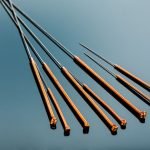Cannabis and Women’s Health: A History- Part 1
JAKE F. FELICE, ND, LMP
Botanical remedies for women’s health have been used for thousands of years. Unfortunately, many of these remedies have long been neglected, ignored, suppressed, or otherwise forgotten. It may be inevitable that important wisdom can be lost, however, if one is to revive it, then the only path forward is through research. One historically useful, yet seemingly overlooked, remedy for women’s ailments is cannabis.
Despite recent scientific advancement and knowledge of the health benefits of cannabis, data regarding its effects on conditions that commonly affect only women remain sparse. Additionally, the historical record reveals much about how cannabis has been used across the globe, but accounts of how it was applied to women’s health are incomplete. It therefore makes sense to explore the historical record, look for clues that support its continued study, and determine if a greater case can be made for using cannabis to treat women’s health issues today.
This article seeks to bring to light some of the early history of cannabis and women’s health and place it in a more scientific, medically relevant context. I will first examine the use of cannabis in ancient traditions in the East and the West, as well as its use into the late 19th century, where cannabis was part of the United States Pharmacopeia. The general thrust of the historical literature supports broad usage of cannabis; however, the strongest case for how it can be helpful in women’s health can be made for its use in treating dysmenorrhea, endometriosis, and menopausal symptoms. My hope is that the following will encourage clinicians to examine cannabis’ potential as a low-toxic alternative or compliment to conventional therapies, both in clinical practice and in the design of future clinical trials.
Historical Use
If one were to take a survey of naturopathic doctors, cannabis would not likely top the list of botanicals used for women (or perhaps even make the list). More common medicinal herbs like Vitex agnus-castus, Actaea racemosa, Caulophyllum thalictriodes, Viburnum opulus, Dioscorea villosa, or Angelica sinensis are much more likely to be mentioned. But cannabis’ use as a botanical specific to women spans Old World and New World cultures, with broad geographical distribution.1 According to the historical data, it has relieved pain and suffering for millennia.1 Although not for everyone, cannabis and cannabinoids can offer effective, well-tolerated, alternative treatment options. Perhaps most impressive about the historical accounts on cannabis and women’s health is the high degree of detail in the writings of Western practitioners in the 19th century (This will be covered in Part 2). Much of the relevant data has been paraphrased from Dr Ethan Russo’s 2008 paper, “Cannabis Treatments in Obstetrics and Gynecology: A Historical Review.”2
China
Cannabis has been cultivated by humans for thousands of years, and it is certain that by 4000 BCE cannabis was cultivated in China.1 Throughout human history, it has had far reaching medical use in China, India, the Middle East, Southeast Asia, South Africa, and South America. 1 In China, evidence has been found that hemp seeds have been used for uterine prolapse, as an aid during childbirth, and to promote lactation; crushed seed kernels and root decoctions have been used for postpartum hemorrhage, retained placenta, or other postpartum difficulties; and flowers have been used for menstrual disorders.2
Egypt and Sumer
Cannabis has been an important part of the Egyptian pharmacopoeia for thousands of years.2 The ancient medical text, The Ebers Papyrus, dated from 1,500 BCE to 3,000 BCE, described cannabis mixed with honey and used vaginally (topically) as an aid for childbirth as well as for a host of other ailments.2 It further described cannabis as being used orally, inhaled, used topically, and applied rectally and vaginally.2 In Mesopotamia, ancient cannabis references on Sumerian and Akkadian stone tablets date to 2,000 BCE.2 They described mixing cannabis with saffron and mint in beer for “difficult childbirth” and “staying the menses.”2
Israel/Palestine and the Middle East
In Israel/Palestine, in a tomb dating from the 4th century AD, the skeletal remains of a 14-year-old pregnant female were found. Researchers determined that her pelvic structure did not have enough room for normal vaginal delivery to occur, and that the girl likely died during childbirth.3 A burnt, gray carbonized material from the abdominal area was analyzed and revealed cannabinoid compounds.3 Researchers concluded “the ashes found in the tomb were cannabis, burned in a vessel and administered to the young girl as an inhalant to facilitate the birth process.”3
In the 9th century, the first Arabic materia medica, known as the Al-Aqrabadhin Al-Saghir, described an intranasal formulation of cannabis seeds and other herbs used to calm uterine pains and prevent miscarriage.2 Evidence has also been found that a succus made from cannabis leaves was used as a diuretic and to treat discharge in diarrhea and ghonorrhea.2 Hemp seed oil was further used to treat uterine tumors and as a uterine relaxant.2 In 17th century Azerbaijan, researchers found evidence that practitioners used a poultice made of cannabis stems and leaves to treat hemerrhoids.2
Early European Traditions
In the 11th century manuscript, The Old English Herbarium, cannabis is mentioned as a remedy for sore breasts.2 A translation of the text reads, “Rub (the herb) with fat, lay it to the breast, and it will disperse the swelling.”2 Evidence from the Codex Vindobonensis 93, thought to be a 13th century Italian copy of a work produced centuries earlier, possibly from Roman sources, indicated a similar topical use of cannabis.2 The manuscript displays an image of the Cannabis plant above a woman’s breasts.2 The Latin inscription details how cannabis, mixed with ointment and applied topically to the breasts, was used to help reduce pain and swelling.2
Tabernaemontanus, a German physician and herbalist, wrote an important work in 1564 titled, the Kräuterbuch of Tabernaemontanus. Researchers have noted, citing this work, that “women stooping due to a disease of the uterus were said to stand up straight again after having inhaled the smoke of burning cannabis.”2 In 1751, Thomas Short described the use of cannabis for treating chronic amenorrhea in his book, Medicina Britannica.2 Short also described using cannabis, mixed with Tanacetum parthenium (feverfew) and Mentha pulegium, for other menstrual irregularities and possibly as an abortifacient (likely due to the addition of pennyroyal).2
To Be Continued
Cannabis, while known primarily for its psychoactive properties, has been used for centuries in a variety of medicinal applications. It is likely that not all of these applications were beneficial, and this includes how physicians may have used cannabis for treating women in the past. The value in examining these historical references is both to highlight how it was used for women historically and that there is a relative lack of information when compared to accounts of cannabis use in general. The same could be said about the current state of cannabis research. There is a lack of study regarding the usefulness and efficacy of cannabis for common women’s health complaints. The accounts compiled by Dr Russo offer isolated examples that, when taken together, show that cannabis was an important tool, used throughout history and in different cultures across the globe.
In Part 2, I will continue reviewing the historical record into the early modern uses of cannabis in Europe and the United States. With the advent of prepared tinctures and solid extracts in 1842, the ability for practitioners to transport, store, and administer specific doses led to widespread use of cannabis.2 Advances in technology also allowed for ease of documentation, and a greater number of written accounts have been preserved from this period. In Part 2, aided both by increased usage and improved documentation of the early 19th century, I will further detail how the older traditions of cannabis use for women evolved into modern times. Finally, I will discuss current research, and what can be taken from the historical data and applied to women’s health issues today.
References:
- Zuardi AW. History of cannabis as a medicine: a review. Braz J Psychiatry. 2006;28(2):153-157.
- Russo E. Cannabis Treatments in Obstetrics and Gynecology: A Historical Review. J Cannabis Ther. 2002;2(3-4):5-35.
- Zias J, Stark H, Sellgman J, et al. Early medical use of cannabis. Nature. 1993;363(6426):215.

Jake F. Felice, ND, LMP is a cannabis author, clinician, educator, and consultant whose vision is to advance the science and practical application of cannabis for medical and recreational markets around the world. Dr Felice provides world-class educational experiences by speaking authentically about hemp and cannabis. He consults with healthcare providers, industry, and the general public. His Category 1 CME courses for doctors, nurses, and pharmacists has been translated into 4 languages. Dr Felice is the founder of Cannabis Matrix Consulting, LLC, and he maintains a regular cannabis blog at drjakefelice.com.










